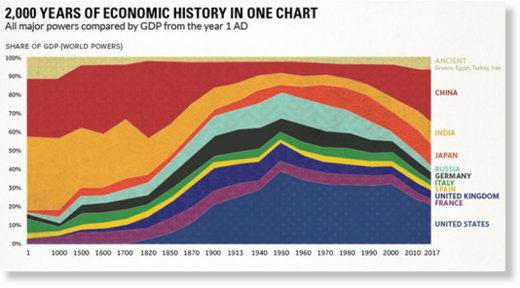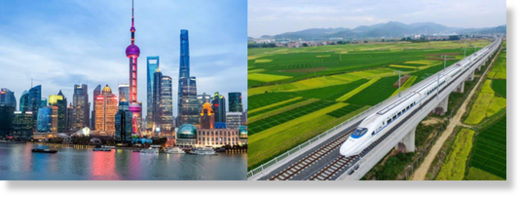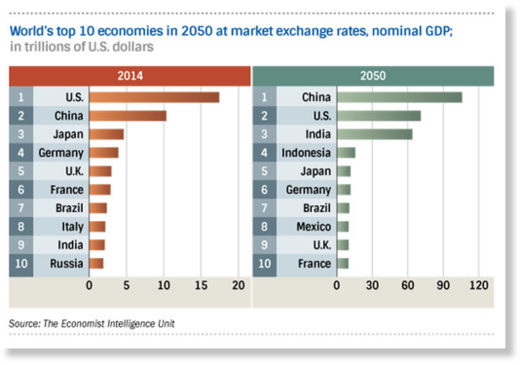How The West Misjudged Asia
Dear diary, I am writing about an ingenious plan that went awry and altered the trajectory of history. The plan was conceived and implemented over a century by my colleagues and their predecessors, the smartest and the most visionary people in the world. Merely 25 years ago, the plan seemed to have come to fruition, and western intellectuals talked not only about the end of the Cold War, but the "end of history." We were excited about the imminent New World Order (which is now referred to as the "international rules-based order"). Then Asia happened.
After WWII, we established an unprecedented system to control half the world. Thus, in 1992, we were confident about bringing in the other half.
In the early 1990s, China and India represented not only 40% of the world's population, but also a vast pool of consumers and diligent workers. After decades of poverty, Chinese and Indians were eager and grateful to embrace capitalism. On the other hand, my colleagues also appreciated the opportunity to make trillions of dollars every year. It was win-win.
The only ones who doubted this plan were those who didn't know that for the first 1,800 years of the last two millennia, the two largest economies in the world were... China and India.
Of course, bringing more than 2 billion people into our system would also mean a sudden loss of jobs, drastic reduction in wages, and a painful drop in the standard of living for many Americans and Europeans. However, that was a small price to pay for our bigger ambition.
India
India worked out splendidly, just as we planned. Although India was hesitant about opening up its economy - understandable given their experiences with British colonialism - we gained their trust by helping millions of Indians emigrate to the West. In return, India privatized most of their major industries, including their media, and allowed us to become major shareholders. Now, India is tightly integrated into our system.
China
Chiiiiina! The biggest prize slipped through our fingers. Most people don't realize that the Tiananmen Square uprising in 1989 was actually a "color revolution" manufactured by the CIA, MI6 and social engineering experts, Gene Sharp and George Soros. We even recruited China's 'Gorbachev' - Zhao Ziyang, the top leader of the Chinese Communist Party. Alas, the plan failed and Zhao Ziyang ended up spending the rest of his life under house arrest.
After that, we decided to pursue a patient approach, since we didn't want to lose China's efficient and cheap factories. Furthermore, we assumed that:
Confounding our expectations, China has become #1 or #2 in many areas of hi-tech industries including solar energy, electric vehicles, smartphones, supercomputers, Artificial Intelligence and mobile payments. 9 out of the top 20 most valuable internet companies are now Chinese. The fact that a Chinese company, ZTE, made the world's first 5G phone call earlier this year should be a "Sputnik Moment" for us.
Worst of all, China has proved the benefits of public banking. Without the government getting into debt, Chinese public banks give massive long-term loans for infrastructure at extremely low interest rates. This has enabled China to build 25,000 Km of high-speed railway systems and modern cities and other infrastructure projects that benefit the Chinese people. Such a socialistic model makes our private banking system look bad!
Finally, we never thought that China would develop a grand vision such as the Belt and Road Initiative. While we build military bases around the world, China is building high-speed railways, highways, seaports, airports, power plants and pipelines in 65 different countries. If this continues, there's no doubt who's going to have more global influence in the near future.
The biggest threat to western dominance is the Made in China 2025 plan. If they achieve expertise in semiconductor chips and a few other industries, we will lose our global hegemony.
Rest of Asia
Something remarkable is happening all over Asia. After WWII, Japan succeeded in a brilliant way, which in turn inspired the so-called Asian Tigers - South Korea, Hong Kong, Taiwan and Singapore. However, the wild fire of enthusiasm really caught on when China lifted 700 million people out of extreme poverty and created the world's largest middle class. Now every country from India to Indonesia to Vietnam feels optimistic and confident that they can succeed as well, and many of them are consistently growing at 6-7% per year. Asians are now far more optimistic than westerners about the direction of their countries.
Asian countries - including even North Korea - have realized that wars and conflicts only get in the way of prosperity. All this is very bad for our divide-and-rule strategy - we were hoping to use Taiwan, Philippines, Japan, South Korea, Vietnam and India to contain China.
If Asia continues to enjoy peace and cooperation, the geopolitical center of gravity will shift dramatically. Many people don't realize that, in terms of purchasing power, China is already larger than the US. In terms of nominal GDP, by 2030, China will be bigger than the US, India will be bigger than Germany, and Asia's GDP will account for 40% of global GDP.
By 2050, the top five world economies could consist of four Asian countries.
While the rising Asian middle class is a lucrative consumer market for our corporations, we dread the rise of multi-national Asian corporations in a decade or two. In other words, we want Asians to be rich enough to buy Colgate and Pampers, but not so rich they can mass produce toothpaste and diapers.
Conclusion
In the early 1970s, David Rockefeller and Henry Kissinger convinced the Chinese elites to open up their economy.
After WWII, we established an unprecedented system to control half the world. Thus, in 1992, we were confident about bringing in the other half.
In the early 1990s, China and India represented not only 40% of the world's population, but also a vast pool of consumers and diligent workers. After decades of poverty, Chinese and Indians were eager and grateful to embrace capitalism. On the other hand, my colleagues also appreciated the opportunity to make trillions of dollars every year. It was win-win.
The only ones who doubted this plan were those who didn't know that for the first 1,800 years of the last two millennia, the two largest economies in the world were... China and India.
Of course, bringing more than 2 billion people into our system would also mean a sudden loss of jobs, drastic reduction in wages, and a painful drop in the standard of living for many Americans and Europeans. However, that was a small price to pay for our bigger ambition.
India
India worked out splendidly, just as we planned. Although India was hesitant about opening up its economy - understandable given their experiences with British colonialism - we gained their trust by helping millions of Indians emigrate to the West. In return, India privatized most of their major industries, including their media, and allowed us to become major shareholders. Now, India is tightly integrated into our system.
China
Chiiiiina! The biggest prize slipped through our fingers. Most people don't realize that the Tiananmen Square uprising in 1989 was actually a "color revolution" manufactured by the CIA, MI6 and social engineering experts, Gene Sharp and George Soros. We even recruited China's 'Gorbachev' - Zhao Ziyang, the top leader of the Chinese Communist Party. Alas, the plan failed and Zhao Ziyang ended up spending the rest of his life under house arrest.
After that, we decided to pursue a patient approach, since we didn't want to lose China's efficient and cheap factories. Furthermore, we assumed that:
- As China got richer, its people would rise up and get rid of the Communist Party
- Western products would always dominate the Chinese consumer market
- Chinese manufacturing would remain stuck in the low/medium-end of the value chain, since innovation is impossible in an authoritarian/despotic society
- China would only become a regional power. Throughout its history, China never showed any skill or interest in foreign relations
Confounding our expectations, China has become #1 or #2 in many areas of hi-tech industries including solar energy, electric vehicles, smartphones, supercomputers, Artificial Intelligence and mobile payments. 9 out of the top 20 most valuable internet companies are now Chinese. The fact that a Chinese company, ZTE, made the world's first 5G phone call earlier this year should be a "Sputnik Moment" for us.
Worst of all, China has proved the benefits of public banking. Without the government getting into debt, Chinese public banks give massive long-term loans for infrastructure at extremely low interest rates. This has enabled China to build 25,000 Km of high-speed railway systems and modern cities and other infrastructure projects that benefit the Chinese people. Such a socialistic model makes our private banking system look bad!
Finally, we never thought that China would develop a grand vision such as the Belt and Road Initiative. While we build military bases around the world, China is building high-speed railways, highways, seaports, airports, power plants and pipelines in 65 different countries. If this continues, there's no doubt who's going to have more global influence in the near future.
The biggest threat to western dominance is the Made in China 2025 plan. If they achieve expertise in semiconductor chips and a few other industries, we will lose our global hegemony.
Rest of Asia
Something remarkable is happening all over Asia. After WWII, Japan succeeded in a brilliant way, which in turn inspired the so-called Asian Tigers - South Korea, Hong Kong, Taiwan and Singapore. However, the wild fire of enthusiasm really caught on when China lifted 700 million people out of extreme poverty and created the world's largest middle class. Now every country from India to Indonesia to Vietnam feels optimistic and confident that they can succeed as well, and many of them are consistently growing at 6-7% per year. Asians are now far more optimistic than westerners about the direction of their countries.
Asian countries - including even North Korea - have realized that wars and conflicts only get in the way of prosperity. All this is very bad for our divide-and-rule strategy - we were hoping to use Taiwan, Philippines, Japan, South Korea, Vietnam and India to contain China.
If Asia continues to enjoy peace and cooperation, the geopolitical center of gravity will shift dramatically. Many people don't realize that, in terms of purchasing power, China is already larger than the US. In terms of nominal GDP, by 2030, China will be bigger than the US, India will be bigger than Germany, and Asia's GDP will account for 40% of global GDP.
By 2050, the top five world economies could consist of four Asian countries.
While the rising Asian middle class is a lucrative consumer market for our corporations, we dread the rise of multi-national Asian corporations in a decade or two. In other words, we want Asians to be rich enough to buy Colgate and Pampers, but not so rich they can mass produce toothpaste and diapers.
Conclusion
In the early 1970s, David Rockefeller and Henry Kissinger convinced the Chinese elites to open up their economy.








Post a Comment